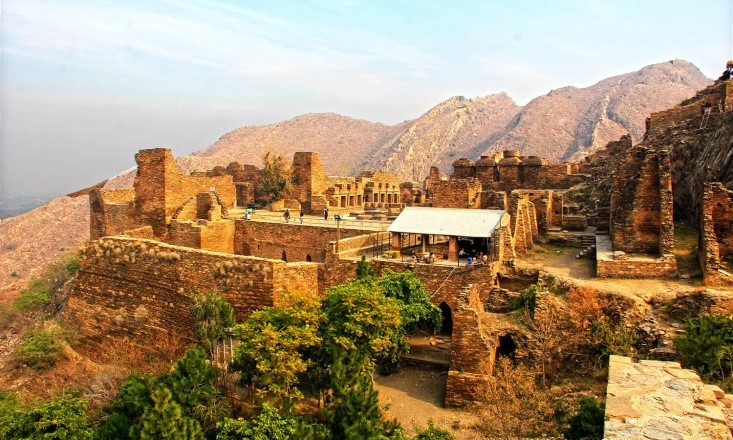Takht-i-Bahi
Takht means “throne” and bahi, “water” or “spring” in Persian/Urdu. The monastic complex was called Takht-i-Bahi because it was built atop a hill and also adjacent to a stream. Located 80 kilometers from Peshawar and 16 kilometers Northwest of the city of Mardan, Takht-I-Bahi was unearthed in early 20th century and in 1980. It was included in the UNESCO World Heritage list as the largest Buddhist remains in Gandhara,
Taxila
The modern town of Taxila is 35 km from Islamabad. Most of the archaeological sites of Taxila (600 BC to 500 AD) are located around Taxila Museum. For over one thousand years, Taxila remained famous as a centre of learning Gandhara art of sculpture, architecture, education and Buddhism in the days of Buddhist glory.
There are over 50 archaeological sites scattered in a radius of 30 kms around Taxila. Some of the most important sites are; Dhamarajika Stupa and Monastery (300 BC – 200 AD), Bhir Mound (600-200 BC), Sirkap (200 BC – 600 AD), Jandial Temple (c.250 BC) and Jaulian Monastery (200 – 600 AD).
Zar Dheri (Gold Mound), Hazara
It is a large monastic complex on the old Silk Route some 26 km from Mansehra (Hazara). It is located on a hillock which was in visual contact with other hill retreats in the area. The complex had a monastery and a stupa resembling Jaulian. There are two caves-cum-tunnels which were possibly used for meditation. It was a fortified place, with bastions and a protective wall made of diaper masonry. It was later used as a citadel. It yielded more than one hundred stone sculptures and architectural panels besides other artifacts.
Mingora
Mingora is a city in Khyber Pakhtunkhua yielding magnificent pieces of Buddhist sculpture and the ruins of great stupa.
Many Buddhist remains and carvings have been discovered near Mingora in the Jambil River Valley. At Panr, a stupa and monastery dated to the 1st century CE has been excavated. At Loe Banr, Butkara II and Matalai, Italian archaeologists unearthed 475 Aryan graves dated between 1520 and 170 BC and two horse skeletons. On the opposite side of the River Swat at Aligrama, near the Saidu Sharif airport, a site of Gandhara grave culture was discovered by Italian archaeologists and dated to 1000 BC.
Swat
The Lush-green valley of Swat District. Swat was once the cradle of Buddhism of all its schools- Little Vehicle, Great Vehicle and the Esoteric sects where once 1,400 monasteries flourished. It was the home of the famous Gandhara School of Sculpture which was an expression of Graeco-Roman form in the local Buddhism tradition.
Archaeologists now know of more than 400 Buddhist sites covering an area of 160 km in Swat valley alone. Among the important excavations of Buddhist sites in Swat an important one is Butkarha-I, containing original relics of the Buddha. A stone carved statues of Buddha, are still existent in the village Ghalegay and Jehanabad Manglawar. There is also a big stupa in Shingardar Ghalegay and other ones are located in Amlukdara near Barikot and Shnasha stupa near Batora village.
Thul Mir Rukan
Stupa of Mir Rukan is one of the few surviving Buddhist monuments in Sindh. Thul Mir Rukan is a 22 m high cylindrical structure, a stupa. It is divided into five sections. The capitals of the pilasters in the circular casing are decorated with cut-brick work and moulded panels at the top.

